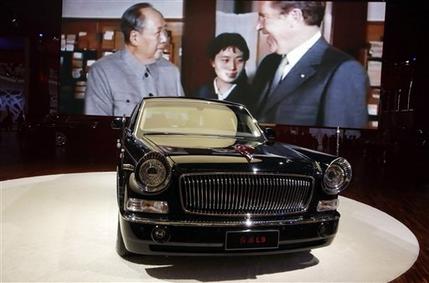BEIJING (AP) — The massive frame, bug-eyed headlights, huge retro front grille and scarlet glass hood ornament can mean only one thing: China’s big and brash Red Flag limousine is back.

The giant homegrown sedans were once among the most distinctive icons of the People’s Republic. Chairman Mao Zedong perched in the back of one to inspect Red Guards in the 1960s. President Richard Nixon rode through Beijing in one during his breakthrough 1972 visit. Bob Hope rode in one too, and was mysteriously told that the trunk was off-limits.
The Red Flag disappeared in the 1980s, replaced by humbler joint efforts with foreign partners that produced boxy Lincoln copies and rebranded black Audis. Now Beijing is reviving the brand to its former glory as a rolling chrome-and-steel embodiment of national pride and ambition.
Since this spring, the newly designed L7 model has conveyed dignitaries including French President Francois Hollande and South Korea’s Park Geun-hye in motorcades from Beijing’s airport.
“China wants to make clear to foreign visitors that it will not become just another Western society with Western goods and taste,” said Jonathan Holslag, a research fellow at the Institute for Contemporary China Studies at the University of Brussels. “China in the first place wants to be different from the West, and in the second place to be respected as a strong, muscular power.”
The L7 is a 6-meter (20-foot) dreadnought of an automobile, boasting a mammoth 12-cylinder engine and roughly resembling an oversized Bentley Flying Spur.
Foreign dignitaries and officials above the rank of minister get the L7, while top-level Chinese officials are chauffeured in an even bigger version, the leviathan L9, which reportedly costs about $800,000 and looks like the kind of car rock stars might drive into swimming pools. Almost 40 centimeters (15 inches) longer than the L7, the L9 comes with an armored chassis, rear-opening “suicide doors” and an optional sun roof from which Chinese leaders emerge when reviewing troops.
Ministerial-level officials are assigned the much more modest H7, which starts at around $50,000.
Chinese car enthusiast Liu Weining, who owns a 2000 version based on the Audi 100 and wishes he could afford one of the latest models, thinks the future of the brand is bright because of its iconic status.
“It’s a sturdy car with a very distinctive look and lots of power,” Liu said. “There’s no other brand like it because so many key events in modern Chinese history have somehow had a connection to Red Flag.”
The cars have featured heavily in coverage of official visits, and drivers say they’ve gotten positive feedback from their distinguished passengers.
“The response from top leaders has been excellent,” said a driver surnamed Zhang who had just ferried a Chinese vice premier in an H7 to a meeting with Nigerian President Goodluck Jonathan at Beijing’s Great Hall of the People.
“It’s as big as the Audis I used to drive, and at least as comfortable,” he said.
The re-emergence of the Red Flag, better known by its Chinese name, Hong Qi (hong-CHEE), coincides with newly installed President Xi Jinping’s promotion of the “China Dream,” a vague concept intended to instill national pride and fire China’s further development.
The Red Flag’s revival “is part of the general attempt to revive respect for the Chinese Communist Party and its revolutionary heritage, rather than worship of things foreign,” said Anthony Saich, a China expert at Harvard University.
“I think it would be odd to promote the China Dream with senior officials riding around in foreign limousines, so it seems to me to be a natural extension of (Xi’s) desire to boost respect and prestige for the made-in-China brand of the revolution,” Saich said.
That plays into China Inc.’s ambition to establish global brands such as Red Flag’s parent company, First Auto Works, more commonly known by its initials FAW.
So far, sales of Chinese car brands in China – the world’s largest car market since 2009 – have been hampered by poor quality, clunky design and less-than-stellar customer service. Foreign makes account for 70 percent of the country’s new car purchases, with the figure rising to 80 percent for vehicles purchased by officials and government agencies.
But local brands are now getting a leg up with a new government policy requiring officials to gradually replace their Audis and Volkswagens with local brands. China’s government is reported to spend up to $16 billion annually on its fleet of roughly 5 million vehicles.
Red Flag’s storied reputation could give it an edge over other local marques, said Klaus Paur, global head of automotive at market research company Ipsos.
“While other Chinese car makers are not really up to the challenge, Red Flag is probably the only domestic brand that may be accepted by Chinese officials as an alternative to international brands,” Paur said. “If Hong Qi is able to succeed with officials, this may also have a positive impact for the private car market.”
One of China’s top three automakers, FAW produces vehicles from buses to SUVs, but the Red Flag has always been its flagship brand.
The Red Flag was hatched in a tossed-off comment by Chairman Mao. Arriving in a Russian limousine at a meeting of the Politburo in 1956, Mao questioned out loud when he would travel “in one of our own sedans.” That led to a prototype in 1958. Production began in earnest in 1959.
For more than two decades, FAW churned out Red Flags in a variety of sizes and styles. In 1965 it introduced Mao’s CA770, which featured a luxury interior and three rows of seating.
Production ended in 1981 under then-leader Deng Xiaoping’s drive to reduce waste and revive the moribund economy through his policy of reform and opening.
In the years that followed, no less than three attempts were made to revive the brand through hook-ups with foreign brands, resulting in such combinations as the CA7465 C8, based on a second-generation Lincoln Town Car, as well as the rebranded Audi 100.
While such iterations haven’t had the gravitas of the classic limos of Mao’s era, the brand has managed to retain its mystique, said Liu, the car enthusiast.
“It’s much more than just a type of automobile,” Liu said. “For the citizens of China, there’s really nothing that can replace it.”





